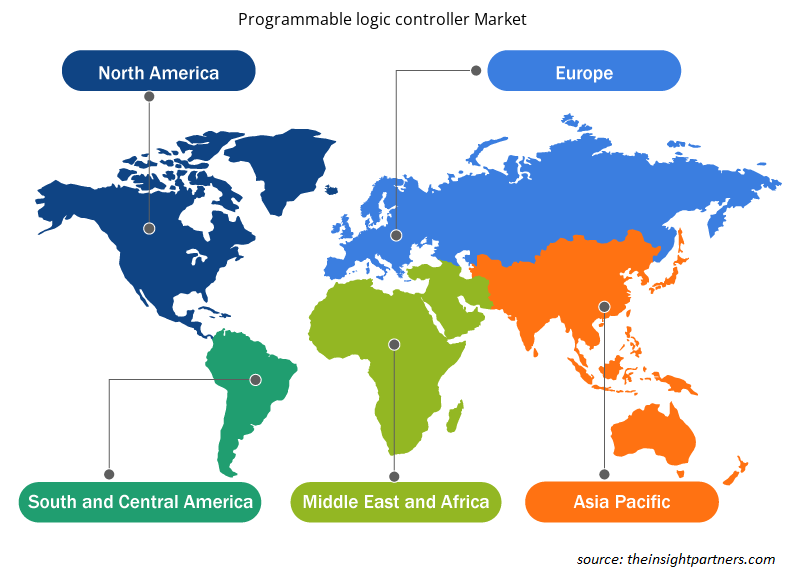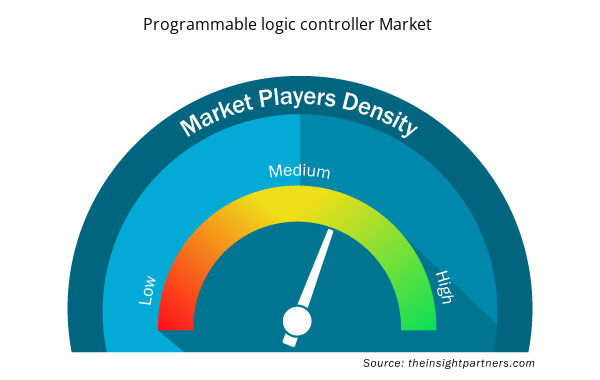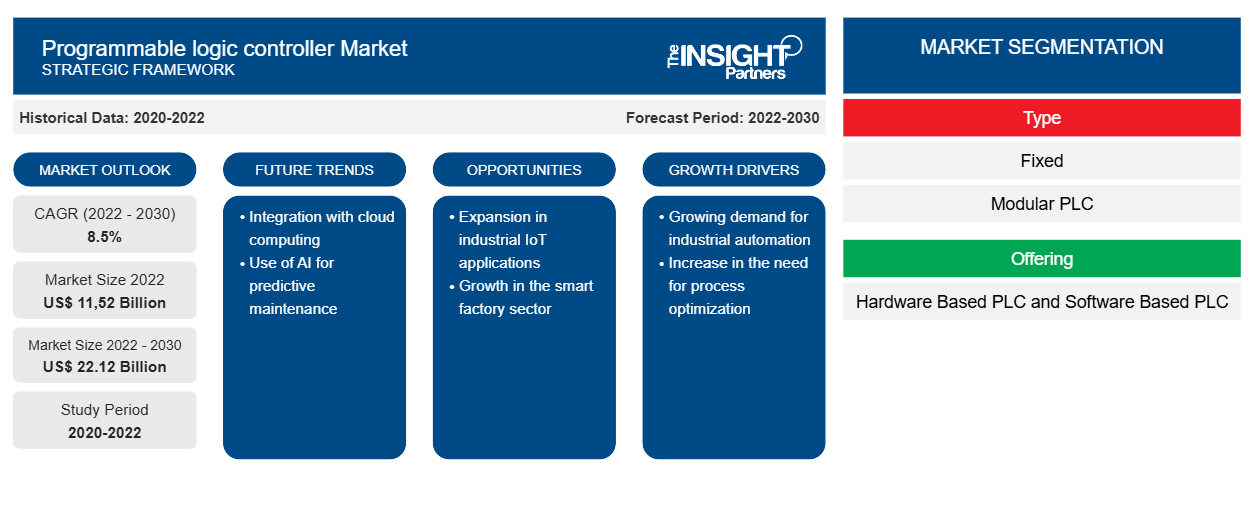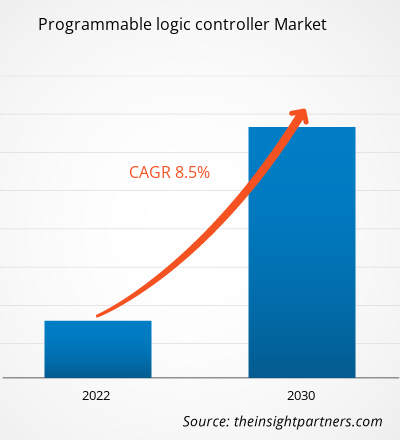[Forschungsbericht] Der Markt für speicherprogrammierbare Steuerungen soll von 11,52 Milliarden US-Dollar im Jahr 2022 auf 22,12 Milliarden US-Dollar im Jahr 2030 wachsen; von 2022 bis 2030 wird ein durchschnittliches jährliches Wachstum des Marktes von 8,5 % erwartet.
Analystenperspektive:
In den letzten Jahren hat die industrielle Automatisierung im globalen Industriesektor an Bedeutung gewonnen. Speicherprogrammierbare Steuerungen (SPS) sind elektronische Geräte, die für Aufgaben wie Überwachung und Steuerung programmiert sind. Die SPS-basierte Automatisierung bietet gegenüber älteren industriellen Automatisierungssystemen verschiedene Vorteile. Produkte auf dem Markt für speicherprogrammierbare Steuerungen sind effizienter, aber weniger teuer in der Wartung als frühere Technologien. Darüber hinaus sind sie flexibler und funktionaler als frühere Systeme, wodurch sie sich gut für die sich ständig ändernden Anforderungen des modernen Industriesektors eignen. Mit dem wachsenden Bewusstsein für die Vorteile von Produkten auf dem Markt für speicherprogrammierbare Steuerungen wird ihre Einführung in den kommenden Jahren wahrscheinlich zunehmen. Ein Produkt auf dem Markt für speicherprogrammierbare Steuerungen ist ein Computer, der für die Überwachung und Handhabung einer Vielzahl von industriellen Prozessen entwickelt wurde, von einfachen Maschinen bis hin zu komplexen Produktionslinien. Diese Steuerungen können mit Sensor- und Steuerungsnetzwerken verbunden werden, sodass sie autonom oder in Zusammenarbeit mit anderen Geräten funktionieren können. Daher sind Produkte auf dem Markt für speicherprogrammierbare Steuerungen für den reibungslosen und effektiven Betrieb industrieller Automatisierungssysteme von entscheidender Bedeutung.
Gut geplante Produktions- und Marketingprozesse sind die Voraussetzungen für Hersteller, um eine „intelligente Fabrik“ aufzubauen, die den Produktionsprozess leichter steuerbar macht, manuelle Eingriffe in die Produktionslinie eliminiert, die rechtzeitige Erfassung korrekter Produktionsliniendaten ermöglicht und die Produktionsplanung verbessert. Zu den auf dem Markt erhältlichen digitalen und analogen Steuergeräten gehören unter anderem SPSen, die das Starten und Stoppen eines Motors, das Öffnen und Schließen von Magnetventilen, das Zählen von Produkten sowie die Steuerung und Einstellung von Temperatur, Druck und Durchfluss steuern. Produkte auf dem Markt für speicherprogrammierbare Steuerungen werden heute in Branchen wie Stahl, Erdöl, Chemie, Elektrizität, Baustoffe, Maschinenbau, Automobil, Textil, Transport, Umweltschutz sowie Kultur und Unterhaltung weithin eingesetzt. So kündigte Siemens im Juni 2023 die Einführung einer vollständig virtuellen SPS an. Die Simatic S7-1500V erweitert das bestehende Simatic-Angebot und unterstützt gleichzeitig die virtuelle SPS-Berechnung.
Marktübersicht für speicherprogrammierbare Steuerungen:
Der Einsatz von speicherprogrammierbaren Steuerungen (SPS) in der industriellen Automatisierung wird wahrscheinlich zunehmen und sich verändern, da die Industriezweige sich in Richtung Industrie 4.0 und dem industriellen Internet der Dinge (IIoT) bewegen. Produkte auf dem Markt wurden in der Vergangenheit als eigenständige Geräte eingesetzt. Aufgrund des wachsenden Trends zur Konnektivität können diese Systeme jetzt jedoch mithilfe von Ethernet und anderen Netzwerkprotokollen mit anderen Geräten und Systemen kommunizieren. Dies ermöglicht den Datenaustausch in Echtzeit sowie die Fernüberwachung und -steuerung. Die Integration von SPS in andere industrielle Steuerungssysteme wird immer beliebter, da Unternehmen versuchen, Prozesse zu rationalisieren und die Effizienz zu verbessern.
Die Reichweite industrieller Steuerungs- und Automatisierungstechnologien geht über den Fertigungssektor hinaus. So lieferte ABB im März 2021 Automatisierungssysteme für Solarkraftwerke mit einer Leistung von 5 Gigatonnen (GW) in Indien mithilfe speicherprogrammierbarer Steuerungen. Das SCADA-System von ABB, eine Automatisierungssteuerungslösung, unterstützt den Betrieb von Solarprojektanlagen, indem es Anlagenbetreibern ermöglicht, Projektdaten von einem einzigen Standort aus zu überwachen und zu analysieren.
Passen Sie diesen Bericht Ihren Anforderungen an
Sie erhalten kostenlose Anpassungen an jedem Bericht, einschließlich Teilen dieses Berichts oder einer Analyse auf Länderebene, eines Excel-Datenpakets sowie tolle Angebote und Rabatte für Start-ups und Universitäten.
- Holen Sie sich die wichtigsten Markttrends aus diesem Bericht.Dieses KOSTENLOSE Beispiel umfasst eine Datenanalyse von Markttrends bis hin zu Schätzungen und Prognosen.
Markttreiber für speicherprogrammierbare Steuerungen:
Die Konsolidierung der Rolle von SPSen in der Industrie 4.0 treibt das Wachstum des Marktes für speicherprogrammierbare Steuerungen voran
Technologische Fortschritte wie künstliche Intelligenz, Cloud Computing, fortschrittliche Sensoren und Big-Data-Analysen haben weiterhin erhebliche Auswirkungen auf die Umgebungen in Industriezweigen. Diese Durchbrüche in der industriellen Technologie werden umgangssprachlich als Industrie 4.0 bezeichnet. SPS spielen eine wichtige Rolle als primäre Steuerung, Eingabezentrale und Schnittstelle für menschliche Bediener in der neuen industriellen Welt. Die SPS-Technologie wird weiter verbessert, um eine bessere Konnektivität mit vielen Eingabesensoren über das industrielle Internet der Dinge (IIoT) zu ermöglichen, wodurch sie als Kernprozessor in Echtzeit-Fertigungsvorgängen dienen können. Infolgedessen können SPS jetzt problemlos riesige Datenmengen erfassen und an maschinelle Lernsysteme weitergeben. Daten von Eingabesensoren und anderen Geräten können beispielsweise mit SPS-Daten kombiniert werden, um das „große Ganze“ zu veranschaulichen, das sich aus den „großen Daten“ ergibt. Werksleiter und Datenanalysten können dann Analysetools einsetzen, um Big Data besser zu verfolgen, Ressourcen zu nutzen, Logistik durchzuführen, Aufträge zu planen und Aufgaben wie die Lieferantenterminierung zu planen, um hocheffiziente Herstellungsprozesse zu entwickeln. Darüber hinaus können „große Daten“ verfolgt und ausgewertet werden, um eine optimale Maschinen- und Geräteleistung und vorbeugende Wartung innerhalb industrieller Systeme zu erreichen.
SPSen haben zusammen mit anderen wichtigen Teilen, die Maschinenschnittstellen und Prozessautomatisierung ermöglichen, in den letzten Jahren eine wesentliche Rolle bei der Digitalisierung der Fertigung gespielt. Im Zuge der Industrie-4.0-Revolution werden sie voraussichtlich auch weiterhin eine wichtige Rolle als primäre Steuerung, Eingabezentrum und Mensch-Maschine-Schnittstelle (HMI) für Arbeiter spielen. Die intelligenten Fabriken der Zukunft werden voraussichtlich durch die Kombination von SPSen, Automatisierung und Robotik florieren. Somit stärkt die konsolidierende Rolle von SPSen in der Industrie 4.0 das Wachstum des Marktes für speicherprogrammierbare Steuerungen.
Marktsegmentanalyse für speicherprogrammierbare Steuerungen:
Basierend auf dem Angebot ist der Markt für speicherprogrammierbare Steuerungen in hardwarebasierte und softwarebasierte SPS unterteilt. SPS sind das Rückgrat von Steuerungssystemen in der industriellen Automatisierung und ermöglichen eine effiziente Überwachung und Steuerung von Prozessen. Sie bestehen aus Hardware- und Softwarekomponenten, die im Tandem arbeiten. In industriellen Umgebungen ersetzt eine Softwarekomponente zunehmend eine gleichwertige Hardwarekomponente. Softwarebasierte speicherprogrammierbare Steuerungen (Soft-SPS) sind zuverlässig, leistungsstark und anpassungsfähig. Im September 2017 gab 3S-Smart Software Solutions, ein Entwickler der herstellerunabhängigen Automatisierungssoftware Codesys IEC 61131-3, bekannt, dass seine SoftPLC-Software jetzt als Laufzeitumgebung für offene Linux-basierte Steuerungssysteme wie Wagos PFC 100 und Siemens Simatic IOT2000 verfügbar ist.
Regionale Marktanalyse für speicherprogrammierbare Steuerungen:
Nordamerika, insbesondere die USA, dominiert aufgrund des technologischen Fortschritts den Sektor der industriellen Automatisierung. Die USA sind ein weltweit anerkannter Industriestandort mit florierenden Branchen wie Automobil, Chemie, Lebensmittel und Getränke sowie Öl und Gas. Dies sind einige der wichtigsten Endverbraucher von speicherprogrammierbaren Steuerungssystemen. Die USA sind einer der größten Automärkte der Welt. Die Verkäufe von leichten Fahrzeugen im Land wurden im Jahr 2020 auf 14,5 Millionen Einheiten geschätzt. In Bezug auf Autoverkäufe und -produktion ist es der zweitgrößte Markt der Welt. Laut Autos Drive America werden ausländische Hersteller bis 2020 5 Millionen Fahrzeuge in den USA produzieren.
verarbeitet die Chemiebranche in den USA Rohstoffe zu über 70.000 Gütern, die für das moderne Leben notwendig sind, und erfüllt damit die Nachfrage von über 750.000 Endverbrauchern im ganzen Land. Zahlreiche Chemieunternehmen im Land – von petrochemischen Herstellern bis hin zu Chemiegroßhändlern – verwenden, produzieren, lagern, transportieren oder liefern Chemikalien über eine komplexe globale Lieferkette. Die enorme Präsenz und operative Reichweite verschiedener Branchen schafft daher die Nachfrage nach speicherprogrammierbaren Steuerungssystemen in den USA.
Umfang des Marktberichts über speicherprogrammierbare Steuerungen
Regionale Einblicke in den Markt für speicherprogrammierbare Steuerungen
Die regionalen Trends und Faktoren, die den Markt für speicherprogrammierbare Steuerungen im Prognosezeitraum beeinflussen, wurden von den Analysten von Insight Partners ausführlich erläutert. In diesem Abschnitt werden auch die Marktsegmente und die Geografie für speicherprogrammierbare Steuerungen in Nordamerika, Europa, im asiatisch-pazifischen Raum, im Nahen Osten und Afrika sowie in Süd- und Mittelamerika erörtert.

- Erhalten Sie regionale Daten zum Markt für speicherprogrammierbare Steuerungen
Umfang des Marktberichts über speicherprogrammierbare Steuerungen
| Berichtsattribut | Details |
|---|---|
| Marktgröße im Jahr 2022 | 11,52 Milliarden US-Dollar |
| Marktgröße bis 2030 | 22,12 Milliarden US-Dollar |
| Globale CAGR (2022 - 2030) | 8,5 % |
| Historische Daten | 2020-2022 |
| Prognosezeitraum | 2022–2030 |
| Abgedeckte Segmente | Nach Typ
|
| Abgedeckte Regionen und Länder | Nordamerika
|
| Marktführer und wichtige Unternehmensprofile |
|
Marktteilnehmerdichte: Der Einfluss auf die Geschäftsdynamik
Der Markt für speicherprogrammierbare Steuerungen wächst rasant, angetrieben durch die steigende Nachfrage der Endnutzer aufgrund von Faktoren wie sich entwickelnden Verbraucherpräferenzen, technologischen Fortschritten und einem größeren Bewusstsein für die Vorteile des Produkts. Mit steigender Nachfrage erweitern Unternehmen ihr Angebot, entwickeln Innovationen, um die Bedürfnisse der Verbraucher zu erfüllen, und nutzen neue Trends, was das Marktwachstum weiter ankurbelt.
Die Marktteilnehmerdichte bezieht sich auf die Verteilung der Firmen oder Unternehmen, die in einem bestimmten Markt oder einer bestimmten Branche tätig sind. Sie gibt an, wie viele Wettbewerber (Marktteilnehmer) in einem bestimmten Marktraum im Verhältnis zu seiner Größe oder seinem gesamten Marktwert präsent sind.
Die wichtigsten auf dem Markt für speicherprogrammierbare Steuerungen tätigen Unternehmen sind:
- Siemens
- Rockwell Automation
- Mitsubishi Electric Corporation
- OMRON Corporation
- Schneider Electric
Haftungsausschluss : Die oben aufgeführten Unternehmen sind nicht in einer bestimmten Reihenfolge aufgeführt.

- Überblick über die wichtigsten Akteure auf dem Markt für speicherprogrammierbare Steuerungen
Analyse der wichtigsten Akteure auf dem Markt für speicherprogrammierbare Steuerungen:
Die Marktanalyse für speicherprogrammierbare Steuerungen umfasst die Profilierung von Unternehmen wie Siemens, Rockwell Automation, Mitsubishi Electric Corporation, OMRON Corporation, Schneider Electric, ABB, Eaton, Honeywell International Inc., Emerson Electric Co. und Hitachi, Ltd.
Aktuelle Entwicklungen auf dem Markt für speicherprogrammierbare Steuerungen:
Anorganische und organische Strategien wie Fusionen und Übernahmen werden von Unternehmen auf dem Markt häufig eingesetzt. Einige der jüngsten wichtigen Entwicklungen sind unten aufgeführt.
- Im April 2023 stellte Siemens auf der Hannover Messe 2023 erstmals eine komplette virtuelle SPS vor. Die Simatic S7-1500V erweitert das bestehende Simatic-Angebot und erfüllt zugleich spezifische Marktanforderungen, wie etwa virtuelles SPS-Computing.
- Im September 2019 kündigte Siemens die Veröffentlichung eines Moduls an, das KI-Funktionen in die Simatic S7-1500-Steuerung und das ET 200MP-E/A-System des Unternehmens integriert. Siemens stellte das Angebot dieses Jahr auf der PACK EXPO in Las Vegas in den USA vor und legte damit den Grundstein für ein zukünftiges Portfolio, das KI auf allen Ebenen der Totally Integrated Automation (TIA)-Architektur von Siemens ermöglicht, einer Kombination aus Hardware und Software, die alles nahtlos miteinander verbindet.
- Historische Analyse (2 Jahre), Basisjahr, Prognose (7 Jahre) mit CAGR
- PEST- und SWOT-Analyse
- Marktgröße Wert/Volumen – Global, Regional, Land
- Branche und Wettbewerbsumfeld
- Excel-Datensatz



Report Coverage
Revenue forecast, Company Analysis, Industry landscape, Growth factors, and Trends

Segment Covered
This text is related
to segments covered.

Regional Scope
North America, Europe, Asia Pacific, Middle East & Africa, South & Central America

Country Scope
This text is related
to country scope.
Häufig gestellte Fragen
The estimated global market size for the programmable logic controller market in 2022 is expected to be around US$ 11.51 billion
1. Increasing Role of PLCs in Industry 4.0
2. Increasing Demand for Automation and Control
Adoption of Soft PLCs
Siemens, Rockwell Automation, Mitsubishi Electric Corporation, OMRON Corporation, Schneider Electric, ABB, Eaton, Honeywell International Inc., Emerson Electric Co., Hitachi, Ltd. are the key market players expected to hold a major market share of programmable logic controller market in 2022
Asia Pacific is expected to register highest CAGR in the programmable logic controller market during the forecast period (2022-2030)
Fixed PLCs segment is expected to hold a major market share of programmable logic controller market in 2022
`United States, China, Germany, and Japan are expected to register high growth rate during the forecast period
The US is expected to hold a major market share of programmable logic controller market in 2022
The global market size of programmable logic controller market by 2030 will be around US$ 22.18 billion
The programmable logic controller market is expected to register an incremental growth value of US$ 10.66 billion during the forecast period
Trends and growth analysis reports related to Electronics and Semiconductor : READ MORE..
The List of Companies - Programmable logic controller Market
- Siemens
- Rockwell Automation
- Mitsubishi Electric Corporation
- OMRON Corporation
- Schneider Electric
- ABB
- Eaton
- Honeywell International Inc.
- Emerson Electric Co.
- Hitachi, Ltd.
The Insight Partners performs research in 4 major stages: Data Collection & Secondary Research, Primary Research, Data Analysis and Data Triangulation & Final Review.
- Data Collection and Secondary Research:
As a market research and consulting firm operating from a decade, we have published and advised several client across the globe. First step for any study will start with an assessment of currently available data and insights from existing reports. Further, historical and current market information is collected from Investor Presentations, Annual Reports, SEC Filings, etc., and other information related to company’s performance and market positioning are gathered from Paid Databases (Factiva, Hoovers, and Reuters) and various other publications available in public domain.
Several associations trade associates, technical forums, institutes, societies and organization are accessed to gain technical as well as market related insights through their publications such as research papers, blogs and press releases related to the studies are referred to get cues about the market. Further, white papers, journals, magazines, and other news articles published in last 3 years are scrutinized and analyzed to understand the current market trends.
- Primary Research:
The primarily interview analysis comprise of data obtained from industry participants interview and answers to survey questions gathered by in-house primary team.
For primary research, interviews are conducted with industry experts/CEOs/Marketing Managers/VPs/Subject Matter Experts from both demand and supply side to get a 360-degree view of the market. The primary team conducts several interviews based on the complexity of the markets to understand the various market trends and dynamics which makes research more credible and precise.
A typical research interview fulfils the following functions:
- Provides first-hand information on the market size, market trends, growth trends, competitive landscape, and outlook
- Validates and strengthens in-house secondary research findings
- Develops the analysis team’s expertise and market understanding
Primary research involves email interactions and telephone interviews for each market, category, segment, and sub-segment across geographies. The participants who typically take part in such a process include, but are not limited to:
- Industry participants: VPs, business development managers, market intelligence managers and national sales managers
- Outside experts: Valuation experts, research analysts and key opinion leaders specializing in the electronics and semiconductor industry.
Below is the breakup of our primary respondents by company, designation, and region:

Once we receive the confirmation from primary research sources or primary respondents, we finalize the base year market estimation and forecast the data as per the macroeconomic and microeconomic factors assessed during data collection.
- Data Analysis:
Once data is validated through both secondary as well as primary respondents, we finalize the market estimations by hypothesis formulation and factor analysis at regional and country level.
- Macro-Economic Factor Analysis:
We analyse macroeconomic indicators such the gross domestic product (GDP), increase in the demand for goods and services across industries, technological advancement, regional economic growth, governmental policies, the influence of COVID-19, PEST analysis, and other aspects. This analysis aids in setting benchmarks for various nations/regions and approximating market splits. Additionally, the general trend of the aforementioned components aid in determining the market's development possibilities.
- Country Level Data:
Various factors that are especially aligned to the country are taken into account to determine the market size for a certain area and country, including the presence of vendors, such as headquarters and offices, the country's GDP, demand patterns, and industry growth. To comprehend the market dynamics for the nation, a number of growth variables, inhibitors, application areas, and current market trends are researched. The aforementioned elements aid in determining the country's overall market's growth potential.
- Company Profile:
The “Table of Contents” is formulated by listing and analyzing more than 25 - 30 companies operating in the market ecosystem across geographies. However, we profile only 10 companies as a standard practice in our syndicate reports. These 10 companies comprise leading, emerging, and regional players. Nonetheless, our analysis is not restricted to the 10 listed companies, we also analyze other companies present in the market to develop a holistic view and understand the prevailing trends. The “Company Profiles” section in the report covers key facts, business description, products & services, financial information, SWOT analysis, and key developments. The financial information presented is extracted from the annual reports and official documents of the publicly listed companies. Upon collecting the information for the sections of respective companies, we verify them via various primary sources and then compile the data in respective company profiles. The company level information helps us in deriving the base number as well as in forecasting the market size.
- Developing Base Number:
Aggregation of sales statistics (2020-2022) and macro-economic factor, and other secondary and primary research insights are utilized to arrive at base number and related market shares for 2022. The data gaps are identified in this step and relevant market data is analyzed, collected from paid primary interviews or databases. On finalizing the base year market size, forecasts are developed on the basis of macro-economic, industry and market growth factors and company level analysis.
- Data Triangulation and Final Review:
The market findings and base year market size calculations are validated from supply as well as demand side. Demand side validations are based on macro-economic factor analysis and benchmarks for respective regions and countries. In case of supply side validations, revenues of major companies are estimated (in case not available) based on industry benchmark, approximate number of employees, product portfolio, and primary interviews revenues are gathered. Further revenue from target product/service segment is assessed to avoid overshooting of market statistics. In case of heavy deviations between supply and demand side values, all thes steps are repeated to achieve synchronization.
We follow an iterative model, wherein we share our research findings with Subject Matter Experts (SME’s) and Key Opinion Leaders (KOLs) until consensus view of the market is not formulated – this model negates any drastic deviation in the opinions of experts. Only validated and universally acceptable research findings are quoted in our reports.
We have important check points that we use to validate our research findings – which we call – data triangulation, where we validate the information, we generate from secondary sources with primary interviews and then we re-validate with our internal data bases and Subject matter experts. This comprehensive model enables us to deliver high quality, reliable data in shortest possible time.


 Holen Sie sich ein kostenloses Muster für diesen Bericht
Holen Sie sich ein kostenloses Muster für diesen Bericht